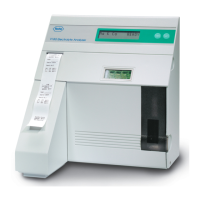
Do you have a question about the Roche 9180 and is the answer not in the manual?
| Type | Electrolyte Analyzer |
|---|---|
| Model | 9180 |
| Sample Type | Whole blood, serum, plasma, urine |
| Manufacturer | Roche |
| Calibration | Automatic calibration |
| Display | LCD |
| Power Requirements | 100-240 VAC, 50/60 Hz |
| Operating Humidity | 20-80% (non-condensing) |
| Measured Parameters | Na+, K+, Cl- |
Provides general safety, usage instructions, incident reporting, and training requirements.
Details warranty terms and conditions for the analyzer.
Lists regulatory approvals and compliance standards met by the analyzer.
Provides manufacturer and local service contact details.
Specifies the analyzer's purpose, application, and intended operators.
Describes the recommended operating environment and explains manual symbols.
Explains safety symbols, signal words, and general precautions.
Covers safe system use, electrical, biohazardous, mechanical safety, and consumables.
Addresses incorrect results, software security, and instrument damage prevention.
Introduces the manual, analyzer, and basic procedures.
Explains how to measure samples and calibrate the instrument.
Discusses result validity and analyzer standby functionality.
Outlines key performance metrics, linearity, and reproducibility data.
Details substances affecting results and analysis limitations.
Information on solutions, QC materials, their specifications, and environmental data.
Provides electrical, classification, dimensional, printer, and display specifications.
Defines normal and critical value ranges for analytes.
Explains the scientific principles behind the analyzer's measurement.
Details electrode construction, use, care, and calibration.
Overview of the analyzer's system and its physical parts.
Specifics on display, keypad, printer, measuring chamber, and pump.
Information on sample probe, valves, SnapPak, rear panel, and name plate.
Guidance on location, setup, electrodes, and initial preparation.
Steps for properly shutting down the analyzer for service or inactivity.
Covers sample collection, requirements, handling, and interference.
Details on performing sample measurements, including urine and direct ISE.
Defines reference values and discusses clinical analysis limitations.
Explains QC principles and the importance of QC.
Steps for setting up QC materials and performing measurements.
Instructions for generating and printing QC reports.
Overview of maintenance, disinfection, and recommended disinfectants.
Details daily, weekly, monthly, and semi-annual maintenance tasks.
Procedures for annual and non-routine maintenance.
Lists common error messages and their causes/actions.
Using service functions to test components like electrodes, sensors, and pump.
Information on service codes, entering/removing codes, and deleting data.
Examples of reports and specifications for solutions.
Maintenance schedule and lists of available accessories and consumables.
Lists supplementary equipment and defines glossary terms.